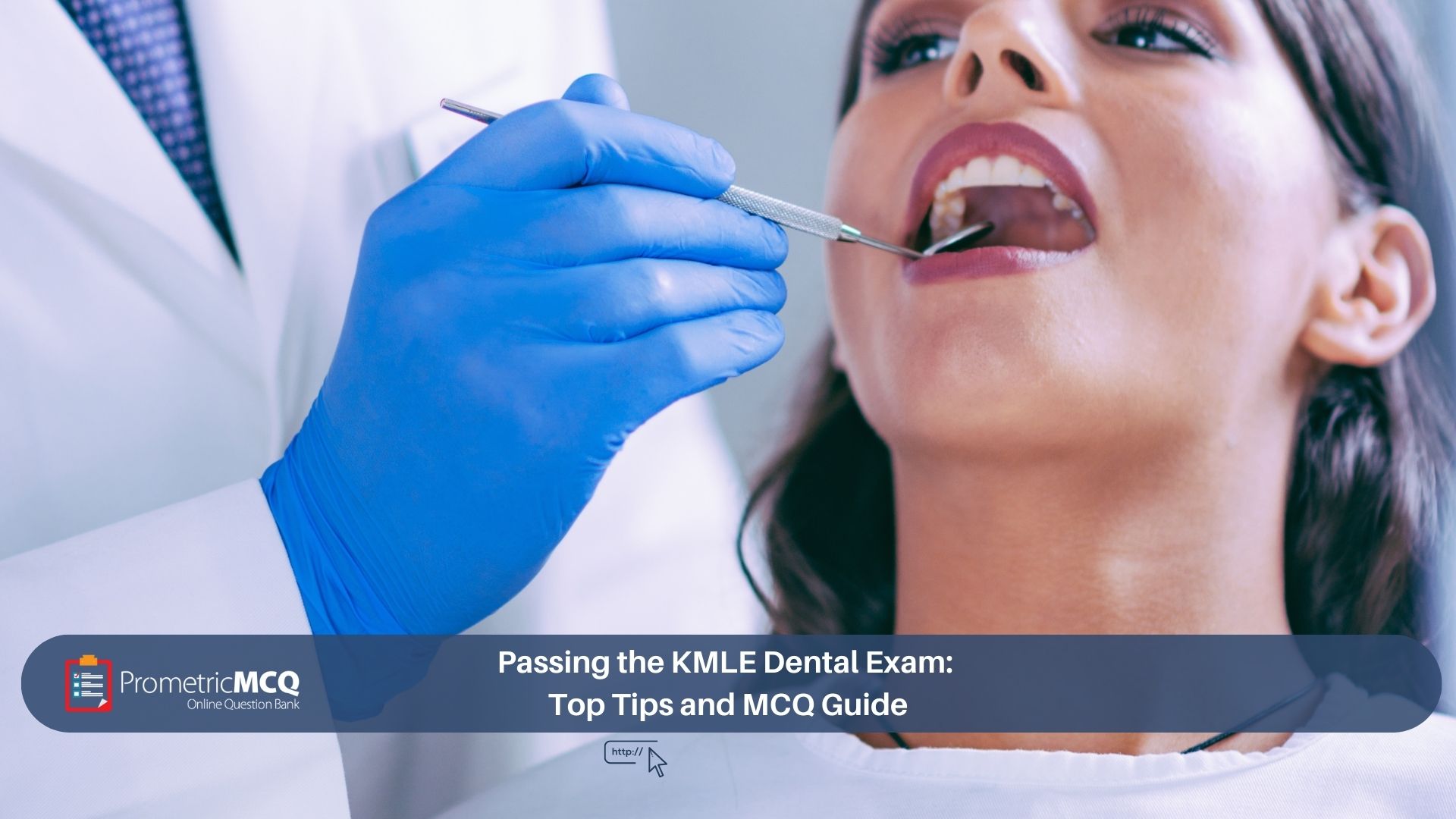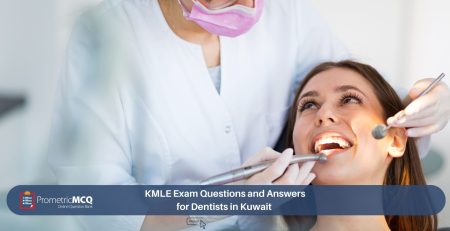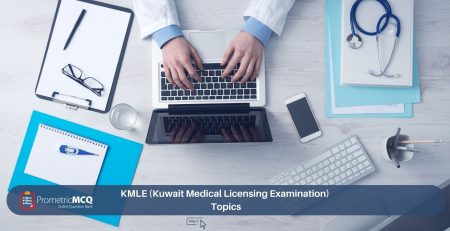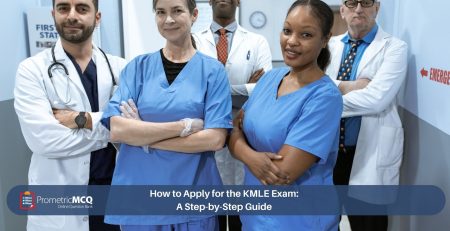
Passing the KMLE Dental Exam: Top Tips and MCQ Guide
fatima@prometricmcq.com2025-09-19T20:02:59+00:00Table of Contents
TogglePassing the KMLE Dental Exam: Top Tips and MCQ Guide (2025)
Kuwait’s sophisticated and rapidly expanding healthcare sector presents a wealth of opportunities for skilled dental professionals from across the globe. To ensure the highest standards of care, the Ministry of Health requires all dentists to pass the Kuwait Medical Licensing Examination (KMLE) before they can practice. This rigorous, computer-based assessment is the primary gatekeeper, designed to validate a dentist’s clinical knowledge, diagnostic acumen, and ability to manage a wide range of oral health issues according to international best practices.
The KMLE is far more than a test of academic recall; it is a comprehensive evaluation of your clinical reasoning. It is built around Multiple-Choice Questions (MCQs) that simulate real-world patient scenarios, challenging you to make accurate diagnoses and formulate sound treatment plans under pressure. Success on this exam hinges on a strategic preparation plan that focuses on high-yield topics and the mastery of the MCQ format itself.
This ultimate 2025 guide is your definitive roadmap to conquering the KMLE Dental Exam. We will provide a thorough deconstruction of the exam’s pattern, a deep dive into the most critical syllabus topics, and a practical guide to tackling case-based MCQs. Featuring realistic sample questions with detailed rationales and a comprehensive 10-point FAQ section, this article is designed to equip you with the knowledge, skills, and confidence to pass on your first attempt and launch your dental career in Kuwait.
Key Takeaways for KMLE Dental Exam Success
- It’s a Clinical Competency Exam: Focus on diagnosis and treatment planning. The exam tests your ability to act like a competent general dentist.
- Radiographic Interpretation is Vital: A significant number of questions will involve interpreting dental radiographs (OPGs, PAs, Bitewings).
- Master the Basics: All major dental specialties are covered. Strong foundational knowledge in Operative, Endo, Prosto, and Oral Surgery is non-negotiable.
- MCQ Strategy is Key: Learning how to dissect clinical vignettes and eliminate incorrect options is as important as knowing the material.
- Practice, Practice, Practice: There is no substitute for solving a large volume of high-quality, case-based MCQs to build speed, accuracy, and confidence.
Deconstructing the 2025 KMLE Dental Exam Pattern
A successful preparation strategy starts with a clear understanding of the exam’s architecture. While the Ministry of Health may update specifics, the core framework administered by Prometric remains consistent. For an overview, you can review our general KMLE exam guide.
1. Test Administrator and Format
The KMLE is a Computer-Based Test (CBT) conducted at secure Prometric test centers worldwide. The format consists of 150 MCQs to be answered in 3 hours (180 minutes). This timing allocates approximately 1 minute and 12 seconds per question, making efficient time management essential.
2. Scoring and Outcome
The exam is graded as Pass/Fail. The Ministry of Health does not provide a numerical score. The unofficial passing threshold is generally considered to be around 60%. A crucial feature is that there is no negative marking, meaning you should always answer every question, even if you have to make an educated guess.
3. Question Style: The Clinical Vignette
The vast majority of questions are case-based. You will be presented with a patient scenario, which may include age, gender, chief complaint, medical history, clinical findings, and often a radiograph or image. You will then be asked to determine the most likely diagnosis, the most appropriate treatment, the best material to use, or the next step in management.
High-Yield Syllabus Domains for the KMLE Dental Exam
Your study plan must be comprehensive, but your focus should be strategic. Prioritize these high-yield domains where the bulk of questions are concentrated.
| Core Dental Domain | High-Yield Topics and Key Concepts for 2025 |
|---|---|
| Operative Dentistry & Cariology | Principles of cavity preparation (G.V. Black), caries diagnosis (visual, radiographic, ICDAS), properties and manipulation of dental amalgam and resin composites, pulp protection (liners, bases), and management of dentin hypersensitivity. |
| Endodontics | Diagnosis of pulpal and periapical diseases (e.g., reversible vs. irreversible pulpitis, acute apical abscess), interpretation of periapical radiographs, root canal treatment procedures (access, instrumentation, obturation), management of endodontic emergencies, and treatment of traumatic dental injuries. |
| Prosthodontics | Fixed: Principles of tooth preparation for crowns and bridges, impression materials and techniques, cementation. Removable: Design principles for complete and partial dentures, diagnosis and management of common denture problems. Basics of dental implants are also included. |
| Oral Surgery & Local Anesthesia | Indications and techniques for routine and surgical extractions, management of impacted teeth (especially third molars), management of post-operative complications (e.g., dry socket, bleeding), pharmacology of local anesthetics and vasoconstrictors, techniques for nerve blocks (e.g., IANB), and management of LA complications. |
| Periodontics | Diagnosis and classification of gingival and periodontal diseases, non-surgical therapy (scaling and root planing), interpretation of periodontal charting and radiographs (bone loss patterns), and understanding the systemic links to periodontal disease (e.g., diabetes). |
| Oral Medicine, Pathology & Radiology | This is a very high-yield area. Key Topics: Recognition of common oral lesions (aphthous ulcers, lichen planus, candidiasis, leukoplakia), radiographic identification of cysts and tumors, oral manifestations of systemic diseases, and principles of radiation safety (ALARA). |
| Pediatric Dentistry (Pedodontics) | Management of caries in primary teeth, pulp therapy for primary teeth (pulpotomy), space maintenance, and management of common pediatric dental trauma. |
A Strategic Guide to KMLE MCQs: Sample Questions & Rationales
The best way to prepare is to put theory into practice. Analyze these sample questions to understand the level of detail and clinical reasoning required. For more extensive practice, using a dedicated bank of dentistry MCQs is essential.
Question 1: Oral Radiology & Diagnosis
An OPG radiograph of an asymptomatic 18-year-old male reveals a well-defined, unilocular radiolucency surrounding the crown of an unerupted mandibular third molar. What is the most likely diagnosis?
- Ameloblastoma
- Odontogenic Keratocyst (OKC)
- Dentigerous Cyst
- Radicular Cyst
Correct Answer: C (Dentigerous Cyst)
Rationale: A dentigerous (or follicular) cyst is a developmental odontogenic cyst that, by definition, forms around the crown of an unerupted or impacted tooth. The radiographic appearance of a well-defined, unilocular radiolucency attached to the cementoenamel junction (CEJ) of an unerupted tooth in a young patient is the classic presentation. It is the most common type of developmental odontogenic cyst.
Why other options are incorrect:
A: An ameloblastoma is a benign but locally aggressive tumor. While it can occur in the posterior mandible, it often presents as a multilocular (“soap bubble” or “honeycomb”) radiolucency, though unilocular variants can occur.
B: An OKC is known for its high recurrence rate and its tendency to grow along the medullary bone without causing significant expansion. While it can be associated with an unerupted tooth, the classic “cyst around the crown” presentation is more indicative of a dentigerous cyst.
D: A radicular (or periapical) cyst is an inflammatory cyst that develops at the apex of a non-vital tooth. It would not be associated with the crown of an unerupted tooth.
Question 2: Operative Dentistry & Materials
While restoring a Class II cavity with a resin composite, a dentist applies a thin layer of a low-viscosity, unfilled or lightly filled resin before placing the composite material. What is the primary purpose of this layer?
- To act as a thermal insulator for the pulp
- To improve the wetting of the cavity surface and reduce voids
- To provide fluoride release and prevent secondary caries
- To increase the overall strength of the restoration
Correct Answer: B (To improve the wetting of the cavity surface and reduce voids)
Rationale: This layer is known as a bonding agent or adhesive. Its primary function is to act as an intermediary between the etched and primed tooth surface (hydrophilic) and the resin composite (hydrophobic). The low-viscosity resin flows into the microscopic irregularities of the etched enamel and dentin, creating micromechanical retention. It thoroughly “wets” the surface, allowing the thicker composite material to adapt closely without creating voids or gaps at the margin, which is critical for a good seal and longevity.
Why other options are incorrect:
A: While some liners/bases provide thermal insulation, the primary purpose of the thin adhesive layer is bonding, not insulation.
C: Fluoride release is a property of materials like glass ionomer cements, not standard bonding agents.
D: The thin adhesive layer contributes very little to the overall bulk strength of the restoration; that property comes from the highly filled composite material itself.
Question 3: Local Anesthesia & Oral Surgery
A dentist administers an inferior alveolar nerve block (IANB) to a patient before a procedure on a mandibular molar. Immediately after the injection, the patient reports that the entire left side of her face feels numb and she is unable to close her left eyelid. What is the most likely cause of this complication?
- Injection into the pterygoid plexus of veins, causing a hematoma
- Anesthetic solution was deposited too far posteriorly, into the parotid gland
- Transient paresthesia of the lingual nerve
- Allergic reaction to the vasoconstrictor in the anesthetic
Correct Answer: B (Anesthetic solution was deposited too far posteriorly, into the parotid gland)
Rationale: The facial nerve (Cranial Nerve VII), which controls the muscles of facial expression (including the orbicularis oculi, which closes the eyelid), travels through the substance of the parotid gland. If the needle during an IANB is advanced too far posteriorly, it can exit the pterygomandibular space and enter the parotid gland. Anesthetic solution deposited here will cause a temporary paralysis of the facial nerve, resulting in unilateral facial droop and the inability to close the eyelid. This is a transient but alarming complication.
Why other options are incorrect:
A: A hematoma would cause swelling and potential trismus but would not cause facial paralysis.
C: Paresthesia of the lingual nerve would cause numbness of the tongue, not the muscles of facial expression.
D: A true allergic reaction would present with systemic signs like rash, hives, or respiratory distress, not localized facial paralysis.
Frequently Asked Questions (FAQs) for the KMLE Dental Exam
The exam is graded on a Pass/Fail basis by the Kuwait Ministry of Health. While an official percentage is not published, the accepted unofficial standard for passing is approximately 60%. To be safe, candidates should aim for a consistent score of 65-70% or higher on practice tests.
While all Gulf dental exams are clinically focused and administered by Prometric, there can be subtle differences in emphasis. The KMLE is known for being a very balanced, generalist exam. It thoroughly tests all core areas of dentistry. For a broader perspective on practicing in the Gulf, our KMLE guide for medical professionals provides useful context.
Unlike some exams that test local laws, the KMLE for dentists is almost entirely focused on international clinical standards and evidence-based practice. You should focus your preparation on globally recognized dental principles and guidelines, such as those promoted by the FDI World Dental Federation.
No, the exam uses generic names and classifications for materials. You need to know the difference between a “hybrid composite” and a “microfill composite,” or the properties of “polysulfide” versus “polyvinyl siloxane” impression materials, not their brand names (e.g., Filtek, Impregum).
After passing the KMLE, you will receive an eligibility certificate or result letter from the Ministry of Health. This result is typically valid for one year, during which you must complete the remaining credentialing and licensing steps and secure employment.
Passing the exam is the first major step. Afterwards, you will need to complete the Primary Source Verification (PSV) of your documents through a designated body. Once your credentials are verified and you have a job offer from a licensed clinic or hospital in Kuwait, your employer will apply to the Ministry of Health for your official license to practice.
The KMLE Dental Exam is conducted exclusively in English. Proficiency in medical and dental English is a prerequisite for taking the exam.
The consensus among successful candidates is that a high-quality, comprehensive question bank (QBank) is the most critical resource. Passive reading of textbooks is not enough. Actively solving thousands of case-based MCQs is the best way to develop the clinical reasoning and speed needed to pass.
The Ministry of Health typically allows candidates a total of three attempts to pass the KMLE. There is usually a waiting period required between attempts. It is crucial to use this time to analyze your weaknesses and adopt a more effective, question-based study strategy.
The final two weeks should be dedicated to consolidation and simulation. Focus on reviewing high-yield topics, especially oral pathology and radiographic interpretation. Take at least two full-length, timed mock exams to perfect your pacing and build mental stamina. Avoid learning new, complex topics. The day before the exam, relax and ensure you get a good night’s sleep.
Conclusion: Your Gateway to a Dental Career in Kuwait
The KMLE Dental Exam is a rigorous but surmountable challenge for the well-prepared dentist. It is a fair assessment of the core competencies required to deliver high-quality dental care. Success is not a matter of chance but the result of a disciplined, strategic, and practice-oriented approach. By focusing on the high-yield domains, mastering the art of the clinical MCQ, and dedicating yourself to a structured study plan, you can confidently pass this exam and unlock the door to a rewarding and prosperous dental career in Kuwait.
Ready to Master the KMLE and Secure Your Future?
Our comprehensive dentistry question bank is filled with high-yield clinical cases, detailed rationales, and simulated exams designed to cover the entire KMLE syllabus and ensure you pass with confidence.










